Glass is a fascinating and accessible collecting area. Despite its fragility, glass from the 18th century and later is relatively easy to find, and plain objects can still be inexpensive.
Introduction
Although the precise origins of glass are unknown, we know it was made in ancient Egypt, Syria and Rome. The basic material was made from heating and fusing silica (usually sand) with a flux (potash or soda) and a stabiliser (usually lime).
Drinking glasses, made in large numbers throughout the 18th century, have long been popular with collectors. Value depends on rarity of the decoration, as well as the shape of the bowl, stem and foot. Many of the more valuable types of 18th-century glass have been faked, so always buy from a reputable source, or take expert advice when in doubt.
Colourful glass of the 19th century is also increasingly popular with collectors. Many new glass-making techniques were introduced during the 19th century and colours became increasingly varied. Cameo glass and overlay glass are two of the most attractive types to look out for, although the best marked examples can be expensive. Unmarked glass of the 19th century is still reasonably priced, and 19th-century table glass can be less expensive than modern equivalents.
Glass types
There are three main types of glass:
Soda glass. Made in Venice from the 13th century. The soda was derived from burned seaweed, and gave the molten glass a malleable quality which allowed glassmakers to create very elaborate shapes.
Potash glass. Made in northern Europe. The potash was derived from burned wood and bracken. Potash glass was particularly suited to cutting and engraving.
Lead glass. Made from potash with the addition of lead oxide (instead of lime), this glass, developed by George Ravenscroft, was used in England and Ireland from the late 17th century, and in Europe from the late 18th century. Lead glass is characterised by its weight and is well suited to cutting.
Decoration
Decoration on glass can add substantially to its value. There are four main decorative techniques used:
Cutting. Cut facets in glass emphasise its refractive (light transmitting) qualities. Cut decoration can help with dating. The earliest patterns were shallow surface cuts. Patterns became increasingly elaborate in the late 18th and early 19th centuries.
Enamelling. Painting in coloured enamels was popular on Venetian glass from the late 15th century and became fashionable in England in the mid-18th century. The best-known English enamellers were the Beilby family. There are two types of enamelling:
- Fire enamelling – where the enamel was painted on the surface of the glass, and the glass fired to fix the decoration. This is the most permanent and usual form of enamelling.
- Cold enamelling (or cold painting) – which involved painting the glass without firing. This technique has the disadvantage that the enamel wears off easily. It was mainly used on inexpensive items.
Gilding. Gold decoration was applied to the surface of the glass in a number of different ways. The most permanent method of gilding was by firing the gold onto the surface of the glass. An alternative method was oil-gilding, which involved applying a gold powder or leaf onto an oil base and burnishing. Gilding applied using this method is easily rubbed off.
Engraving. There are four types of engraving:
- Diamond point engraving. The design was scratched onto the surface of the glass using a tool with a diamond nib. This technique was used in 16th-century Venice, and in England in the late 16th century.
- Wheel engraving. The design was engraved using small copper wheels of varying diameter which rotated against the surface of the glass. The technique was used in Germany in the 17th century, and became the most common form of engraving in England from the 18th century.
- Stipple engraving. A fine diamond needle was tapped and drawn on the surface to form a design built up from dots and small lines. This technique was popular in the Netherlands in the 18th century and is also found on English glasses.
- Acid etching. This technique involved covering the surface of the glass with varnish or grease, and scratching the design with a needle or sharp tool. The surface was then exposed to hydrofluoric acid which etched the design on the glass. This method was popular in the 19th century.
Authenticity
Fakes of many of the more expensive types of antique glass abound. Victorian glassmakers made imitations of 18th-century glass and many fakes have also been produced in the 20th century. These are often discernible in three key ways:
Colour. The distinctive tint caused by impurities may not be present in reproductions.
Manufacturing methods. Hand-blown glass usually has a pontil mark – a rough bump under the stem – where it was cut from the pontil rod. It may have striations or ripples in the glass and the rim may be of uneven thickness. Later, machine-made glass doesn’t have these imperfections.
Proportions. Glass has varied in style and proportion throughout the centuries. On old glasses, the foot is usually as wide as the bowl. The wrong proportions may indicate a fake.
Coloured glass
Coloured drinking glasses and decanters were produced in relatively small quantities in England during the 18th century. But 18th-century styles were much copied in the late 19th and early 20th century and some later versions are so convincing that even experienced collectors can be confused. Most of the coloured glass you’ll come across dates from after 1800, when many lavishly decorated glass objects were made both in Britain and on the Continent.
Opaline glass
At first glance the goblet above looks as if it’s made from porcelain, but it’s actually an example of English opaline glass, made in about 1850. Much opaline glass was also made in France. Quality can vary – the best pieces are made from lead crystal and are very heavy. A piece like this would cost at least £300.
What to look for
- pieces marked by the workshops of Thomas Webb, WHB & J Richardson and Stephens & Williams
- larger pieces
- multiple layers of glass
- high-quality design, especially neoclassical figures
Cameo glass
Cameo glass is one of the more expensive types of 19th-century coloured glass. It was made by overlaying the base colour with a layer of contrasting glass which was then carved to reveal the colour underneath.
This large bottle has a silver lid, so it’s worth £1,500 to £2,000. But even miniature bottles would be worth £200.
Ruby glass
Ruby glass was produced both in Bohemia and England. It was sometimes made from tinted glass or from clear glass with a ruby stain on the surface.
These two pieces were made in England in the mid 19th century. The value of the piece on the left is high at £2,500 to £3,000 because of the elaborate silver gilt handles, while the less ornate jug on the right is worth between £400 and £600.
Cut and pressed glass
Nothing makes glass sparkle more brightly than cut decoration. Press-moulded glass, which looks like cut glass but costs less, became popular with the demand for inexpensive glass wares.
Cut glass
Early glass was simply cut by hand in fairly shallow patterns, but gradually patterns became deeper and designs more elaborate, and by about 1830 mechanised wheel cutting became the norm. Although 18th-century cut glass is becoming more popular with collectors, it can still be good value.
If you want to collect cut glass to use on the dining table look out for jelly, custard and sweetmeat dishes, fruit bowls and candlesticks. Many of these are still relatively inexpensive, especially if you buy them singly.
The handkerchief test
Plain early glass has sometimes been decorated with later engraving to make it seem more valuable. To check the decoration is authentic, drop a white handkerchief in the glass – old engraving will look dark and grey against the cloth, while new engraving will seem white and powdery. A handkerchief or white cloth is also useful to show up the colour of the glass itself.
Later cut glass
Extensive sets of less elaborate cut glass from the early 20th century can still be very affordable. The glasses, bowls and plates shown at the start of the page are part of a set of 89 items made in about 1900. The whole set would cost about £250 to £350.
Irish glass
If you see a piece of glass which looks rather lopsided the chances are it’s Irish! Glasses made in Ireland, such as this bowl, can also often be identified by its greyish tinge and the typical shallow diamond cutting. A piece like this would be worth about £600.
Rock crystal
Rock crystal glass is engraved lead glass that’s been cut and polished to simulate the natural facets of rock crystal. It became popular during the late 19th century. A rock crystal item like this would cost about £250 to £350.
Pressed glass
During the Victorian period clear and coloured pressed glass plates were often made to commemorate important events. This one, worth £30 to £40, celebrates Queen Victoria’s Golden Jubilee.
Cut or pressed?
Cut glass is usually far more desirable and valuable than pressed glass, and there are several ways of identifying it:
- sharply faceted decoration
- no mould lines inside
- irregular thickness
Cut glass patterns
These are some of the most common cut glass patterns used during the 18th and 19th centuries. However, because they have been repeated in the 20th century, the pattern alone is not a reliable guarantee of authenticity. You should also look for the colour of the glass and for irregularities that show it’s handmade.
Drinking glasses and decanters
Compared with ceramics of the same date, much antique glass remains inexpensive. In face, an antique decanter will often cost less than a modern one.
Building a collection
The variety of glasses available means that there are many ways to specialise in collecting. You may decide to focus your collection on, say, air twists, Jacobite glass, cordials, or gilded glass, or you may prefer to collect single examples of each type. Simpler 18th-century glasses may cost £50 to £100, but those with elaborate or unusual decoration can be much more valuable.
Glass shapes
Collectors categorise and value glasses according to the shape and decoration of the bowl, stem and foot. The 1720 glass shown at the top of the page is of medium quality – it has a plain bowl and a relatively simple stem. But because it’s relatively large, at 23cm (9in) high, it’s worth about £500.
Glass stems
The glass at the top of the page is a multi-knopped stem, so called because of the series of projections that decorate it. Some stems have only one knop, which may contain a teardrop of air, while other stems are decorated with air twists.
Typical stem decorations include:
- multiple spiral
- single series
- double series
Glass bowls
The bowl of the glass above is a round funnel shape. Other bowl shapes are:
- bucket
- waisted bucket
- conical
- bell
- ogee
- trumpet
Glass feet
The glass above has a domed foot, characteristic of many early glasses. Others have conical feet. Check the edge of the rim for unevenness, as this may mean a chip has been ground down.
- conical foot
- domed foot
Colour twists
Stems with threads of coloured glass are keenly sought after. The value depends on the number of colours. This one has blue and opaque white twists, and would be worth about £1,500.
Gilded glass
Glasses with original, soft 18th-century gilding, such as this one, are very desirable, but are rarely seen in perfect condition. This glass would be worth at least £500.
You can spot less desirable later gilding by its harder, brighter appearance.
Signs of age
- a foot that’s wider than the rim
- flaws in the glass indicating it was handmade
- a bumpy mark, called a pontil mark, under the foot
- a greenish or greyish tinge in the glass
- signs of wear on the foot in the form of fine and irregular scratches
Jacobite glasses
Glasses engraved with roses, doves and oak leaves were made in the 18th century to show furtive allegiance to the Old Pretender (James Edward Stuart) and the Young Pretender (Charles Edward Stuart).
Jacobite glasses are particularly collectable but can be expensive – an especially rare one was sold in 1992 for £66,000.
Decanters
Decanters were often decorated with engraved or gilded labels describing their contents. This one is made from Bristol blue glass. Bristol is an area associated with coloured decanters, although not all were made there.


































